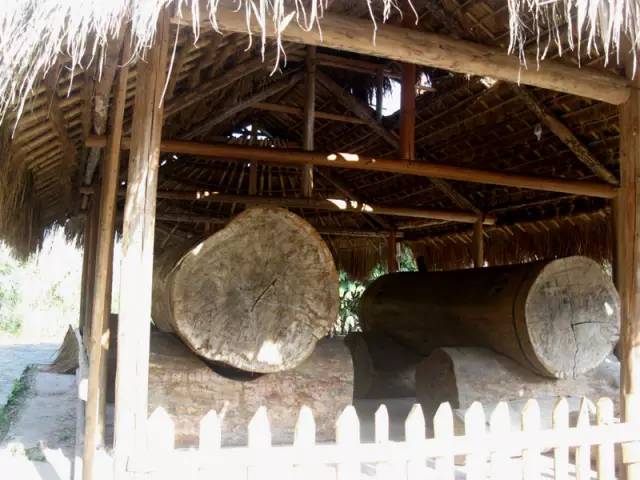
Wooden Drum House in Ximeng County, Puer
Overview
The Wooden Drum House (木鼓房, Mùgǔfáng) is a small pavilion constructed with six pillars, three beams, and bamboo or thatch, characterized by its lack of surrounding walls. It serves as an important and iconic structure in Wa (佤族, Wǎzú) villages. Each village typically has one or more of these drum houses. Despite its modest size and simple design, the Wooden Drum House holds a sacred status as it is used to store wooden drums, functioning similarly to temples in other cultures.
Significance of the Wooden Drum
The wooden drum, known as Keluò (克罗) in the Wa language, symbolizes the Wa people and is regarded as a sacred object of worship. The Wa believe that the wooden drum is a “spiritual vessel” and a “heavenly drum,” emphasizing its essential role in their lives: “Life depends on water, prosperity relies on the wooden drum.” Thus, it is generally not to be touched except during significant collective events such as sacrifices and festivals.
Wooden Drum Dance
The Wooden Drum Dance (木鼓舞, Mùgǔwǔ) is a traditional dance passed down through generations in the Wa villages of Ximeng County. It is one of the oldest and most representative folk dances in the region. The dance revolves around the wooden drum, which plays a central role in Wa rituals and celebrations.
The Wa people’s wooden drum is used not only for rituals but also as a musical instrument and a signaling device. The drum’s origins trace back to totem worship in matriarchal societies. Each Wa village has its Wooden Drum House, which houses the drum and hosts various ritual activities. During the New Water Festival (新水节, Xīnshuǐjié), the first bucket of fresh water is offered to the wooden drum, and at the New Rice Festival (新米节, Xīnmǐjié), the first bowl of new rice is also presented. Various sacrificial ceremonies, such as head-hunting rituals and cattle ceremonies, are centered around the wooden drum.
Characteristics of the Wooden Drum Dance
The Wooden Drum Dance is a collective performance involving two to four people striking the drum with wooden mallets to produce varying tones. The basic movements of the dance include standing shoulder-width apart, half-squatting, and turning the hips while occasionally lifting one foot to perform a “three-bend” motion. The performers may also spin while waving the mallet. As the dance reaches its climax, the movements become more vigorous, with participants dancing energetically around the drum, accompanied by intense drumming.
The dance features solid, primitive, and robust movements that exhibit the unique style and strong ethnic characteristics of the Wa people, reflecting their bold and passionate spirit.
Cultural Significance
The Wooden Drum Dance encapsulates the evolution and development of Wa culture, portraying their historical customs and aesthetic consciousness. It is rich in both ethnic and local characteristics. Since the 1980s, the dance has emerged as a symbol of the Wa people, gaining recognition beyond Yunnan Province and reaching an international audience. It has been featured in various cultural exhibitions both domestically and internationally, significantly impacting the promotion of Wa culture. In 2013, it was included in the third batch of provincial intangible cultural heritage listings in Yunnan Province.
How to Get There
By Car: From Pu’er (普洱), drive southwest towards Ximeng County (西盟县). The Wooden Drum House is located within the Wa villages in this area.
Public Transportation: Local buses operate from Pu’er to Ximeng County. From the county seat, you can take a taxi to reach the specific villages where the Wooden Drum Houses are located.
Travel Tips
- Respect the Sacredness: Be mindful of the cultural significance of the Wooden Drum House and refrain from touching the drums without permission.
- Engage with Performers: If possible, interact with local dancers and learn more about the dance’s significance and techniques.
- Try Local Cuisine: Enjoy traditional Wa foods available in nearby villages to enhance your cultural experience.
- Capture Memories: Bring a camera to document your visit, but ensure to ask permission before taking photos of people and sacred sites.
- Participate in Festivals: If your visit coincides with local festivals, be sure to participate in or observe the celebrations to gain a deeper understanding of Wa culture.


 7 Days GolfingTour
7 Days GolfingTour
 8 Days Group Tour
8 Days Group Tour
 8 Days Yunnan Tour
8 Days Yunnan Tour
 7 Days Shangri La Hiking
7 Days Shangri La Hiking
 11 Days Yunnan Tour
11 Days Yunnan Tour
 6 Days Yuanyang Terraces
6 Days Yuanyang Terraces
 11 Days Yunnan Tour
11 Days Yunnan Tour
 8 Days South Yunnan
8 Days South Yunnan
 7 Days Tea Tour
7 Days Tea Tour
 8 Days Muslim Tour
8 Days Muslim Tour
 12 Days Self-Driving
12 Days Self-Driving
 4 Days Haba Climbing
4 Days Haba Climbing
 Tiger Leaping Gorge
Tiger Leaping Gorge
 Stone Forest
Stone Forest
 Yunnan-Tibet
Yunnan-Tibet
 Hani Rice Terraces
Hani Rice Terraces
 Kunming
Kunming
 Lijiang
Lijiang
 Shangri-la
Shangri-la
 Dali
Dali
 XishuangBanna
XishuangBanna
 Honghe
Honghe
 Kunming
Kunming
 Lijiang
Lijiang
 Shangri-la
Shangri-la
 Yuanyang Rice Terraces
Yuanyang Rice Terraces
 Nujiang
Nujiang
 XishuangBanna
XishuangBanna
 Spring City Golf
Spring City Golf
 Snow Mountain Golf
Snow Mountain Golf
 Stone Mountain Golf
Stone Mountain Golf















